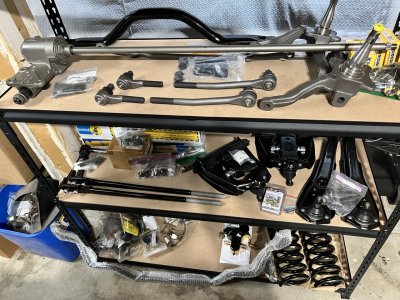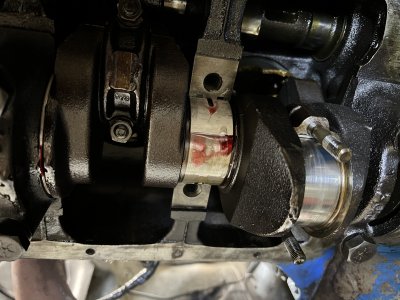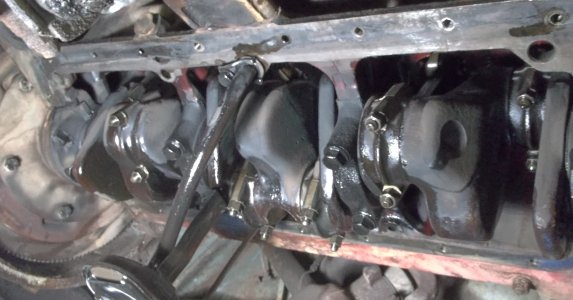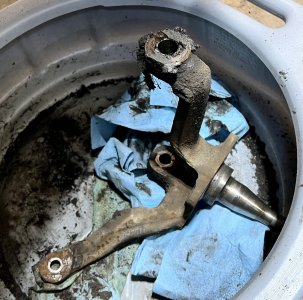Another word of encouragement, I replaced bearing while engine was still in car, rods and mains, several yrs ago no, I think I used the screwdriver method, it might have been a pick too. The top bearings rotated quite easily. It was a daily driver at the time. No problems and good oil pressure 
You are using an out of date browser. It may not display this or other websites correctly.
You should upgrade or use an alternative browser.
You should upgrade or use an alternative browser.
All Small Six Uh-oh. Found this in my oil pan.
- Thread starter funkaholik
- Start date
This relates to all small sixes
I would guess that is an originalHere is the lower thrust bearing. They are FoMoCo, so they are either original (doubt that) or were replaced when these parts were still available from Ford. I believe that the “A” suffix means that they are standard and not oversized. That jives with the measurement I took of the crank journal. Since I have to order the whole set anyway, I’ll look at the other bearings and possibly replace them, too. I’ve never done this with the crank in the car before, but there’s a first time for everything! I’m going to see what I can find about the proper procedure online. Any tips here? I’m especially interested in the best way to get the block side bearing out. I’m assuming I pull one cap at a time, replace the bearing, and then retorque that cap before moving onto the next one. I will use a liberal amount of engine assembly lube. I have the manual here with the end play specifications (0.004-0.008), so I will check those before I run the engine. I guess I should replace the rear main seal while I have the cap off.
I bought this car two months ago, and it was a really good deal. So if I can pull this off, I am ahead of the game. I don’t know anything about the history of this engine, but it looks a little grungy inside, as if oil maintenance schedules weren’t followed that closely.
View attachment 22626
Do not ding up the crankshaft X2
Rods bearings usually wear more than mains.
Rods bearings usually wear more than mains.
Ditto. V8 Olds developed a rod knock. F150/300 just rattling everywhere. Rambler, intermittent main bearing knock at idle. All fixed from underneath, all run quiet again with STD. sized bearings. Learned about the "roll in" bearing method way back in the commercial fishing business: the deck is built after the engine is in, they ain't coming out without cutting a big hole. Then semi trucks- unless it blows up the blocks are in the frame for life, rebuilds are done in-frame.Another word of encouragement, I replaced bearing while engine was still in car, rods and mains, several yrs ago no, I think I used the screwdriver method, it might have been a pick too. The top bearings rotated quite easily. It was a daily driver at the time. No problems and good oil pressure
funkholik, replace the rod bearings while you're in there. The engines I listed above, did both rods and mains. Runs "good as new".Do not ding up the crankshaft X2
Rods bearings usually wear more than mains.
As "encouragement" here's a pic of my '59 flathead 6 after the bearing swap, lying underneath the car. About 4 months ago. It had the same problem yours has- high wear on the thrust flange of the thrust main bearing. (It wasn't broken off though, lol.) The forged crank is 10X overkill for this 90 HP engine.
Attachments
I would try to find a brass or bronze bladed screwdriver or some other non marring material to use to tap it out enough that you can grab it and roll it out. Once you get the shell out roll the crank so you can see all sides inspect the thrust surfaces of the crank and where shell seats against the block. If everything looks good roll a new one in and call it good.
PSIG
Famous Member
If you feel this is an old damage, then this is likely not necessary. But for more recent or worse issues (wiping a cam lobe or similar), I try to get as much hidden nasty stuff out as I can before it makes more damage after the repair.
When you get it back together, I would run the fresh oil for only one warmup and test drive, using a non-bypass filter, so all the oil goes through the filter, catching any loose particles from pieces or repairs before it goes back through the engine. For this I use the WIX 51647, which is the same as the standard filter, but no internal bypass valve. The one caveat with this is to not rev the engine until it is fully warmed, to prevent collapsing the filter with cold, thick oil.
Many use non-bypass filters all the time without issues, but over-pressure could be an issue, so take it easy until warm.
When you get it back together, I would run the fresh oil for only one warmup and test drive, using a non-bypass filter, so all the oil goes through the filter, catching any loose particles from pieces or repairs before it goes back through the engine. For this I use the WIX 51647, which is the same as the standard filter, but no internal bypass valve. The one caveat with this is to not rev the engine until it is fully warmed, to prevent collapsing the filter with cold, thick oil.
Many use non-bypass filters all the time without issues, but over-pressure could be an issue, so take it easy until warm.
Thank you again everyone for your advice and encouragement. It really helps to hear that several of you have done this procedure before with good results.
I'm going to pull a rod bearing to check the size (though since the mains are FoMoCo standard, I'll bet the rods are too) then order a set of rod bearings so I can do this all at once.
@PSIG Good tip on running the non-bypass filter for the initial run-in. I'll order that Wix 51647.
It's funny that this oil pan gasket change was just because I had all the steering linkage off to replace the steering and suspension parts, and thought this would be the easiest time to replace the leaking pan gasket. What a can of worms I opened. Still, I can't complain since I'm SO glad I found this now before it got catastrophic.
Eventually all these bearings will get replaced, and then I can get back to putting all this stuff on:

I'm going to pull a rod bearing to check the size (though since the mains are FoMoCo standard, I'll bet the rods are too) then order a set of rod bearings so I can do this all at once.
@PSIG Good tip on running the non-bypass filter for the initial run-in. I'll order that Wix 51647.
It's funny that this oil pan gasket change was just because I had all the steering linkage off to replace the steering and suspension parts, and thought this would be the easiest time to replace the leaking pan gasket. What a can of worms I opened. Still, I can't complain since I'm SO glad I found this now before it got catastrophic.
Eventually all these bearings will get replaced, and then I can get back to putting all this stuff on:

The goodie rack!!Thank you again everyone for your advice and encouragement. It really helps to hear that several of you have done this procedure before with good results.
I'm going to pull a rod bearing to check the size (though since the mains are FoMoCo standard, I'll bet the rods are too) then order a set of rod bearings so I can do this all at once.
@PSIG Good tip on running the non-bypass filter for the initial run-in. I'll order that Wix 51647.
It's funny that this oil pan gasket change was just because I had all the steering linkage off to replace the steering and suspension parts, and thought this would be the easiest time to replace the leaking pan gasket. What a can of worms I opened. Still, I can't complain since I'm SO glad I found this now before it got catastrophic.
Eventually all these bearings will get replaced, and then I can get back to putting all this stuff on:
View attachment 22658
In preparation for this job I looked up the torque specs for the rod bolts: 19-24 ft/lbs.
Is that for real? That seems absurdly low.
Is that for real? That seems absurdly low.
That makes sense.
I assume that since these only torque to 24 ft/lbs, I don't have to measure bolt stretch and that these bolts can be reused.
I noticed that there are no ARP bolts made for the small six rods, only the big six.
I assume that since these only torque to 24 ft/lbs, I don't have to measure bolt stretch and that these bolts can be reused.
I noticed that there are no ARP bolts made for the small six rods, only the big six.
200 uses 289 5/16'' bolts. It is best practice to recondition/resize the rod if bolts are changed.
I have gotten away with it before not doing it. Sometimes you have to do what you have do.
Make sure that you can see the numbers on the rod and the cap to make sure that you know how to reinstall the cap, they have to go back on the way they were machined.
Ford bolts are good bolts and can be reused if they have not been under or over torqued, or the threads damaged, Have they? that is always the unknown question.
I have gotten away with it before not doing it. Sometimes you have to do what you have do.
Make sure that you can see the numbers on the rod and the cap to make sure that you know how to reinstall the cap, they have to go back on the way they were machined.
Ford bolts are good bolts and can be reused if they have not been under or over torqued, or the threads damaged, Have they? that is always the unknown question.
Last edited:
Well I rolled in all but bearing #7 today and it went smoothly. Didn’t do 7 yet since I decided to replace the main seal at the same time (currently installed is old rope style, and not even clocked. Hard as a rock and leaking) but I opened up the package for the new rear seal I ordered and they only sent me ½ of one. Very helpful. So while I wait for a whole one to arrive, I’ll start on the rod bearing swaps tomorrow.
Here is #6 going in, next to the #6 rod cap I already had pulled to check if they were standard size.
Many, many thanks to all who gave me advice and encouragement here in this forum. I probably wouldn’t have attempted this without it.

Here is #6 going in, next to the #6 rod cap I already had pulled to check if they were standard size.
Many, many thanks to all who gave me advice and encouragement here in this forum. I probably wouldn’t have attempted this without it.

Of course you know to remove the sharp pin in the #7 cap when you go to the rubber seal.
Remember that engine parts may seem heavy and strong, but they can be jacked out of wack if not careful.
Sometimes you can tell if the engine was rebuild by someone not experienced, if the rod spit/spurt hole bump is not facing away from the cam like it should be and is toward the cam.
To be clear, the bump is to face the major thrust side of the cylinder which is away from the cam toward the US passenger side.
From what I can see yours looks right.
Remember that engine parts may seem heavy and strong, but they can be jacked out of wack if not careful.
Sometimes you can tell if the engine was rebuild by someone not experienced, if the rod spit/spurt hole bump is not facing away from the cam like it should be and is toward the cam.
To be clear, the bump is to face the major thrust side of the cylinder which is away from the cam toward the US passenger side.
From what I can see yours looks right.
Last edited:
Well, all the bearings and the rear main seal have been swapped, rods and mains torqued down in stages to specs, oil pump is back on, and I put on the non-bypass filter that @PSIG recommended. Cleaned up the pan and block surfaces and I'll get the pan on in the morning. Then I guess it's finally time to put all these steering and suspension parts on and get Lois back down on her tires. After that I'll pull the distributor, prime the oil pump, fire her up oh so gently, and hope for the best...
Make sure that you do not drop the oil pump driveshaft into the pan and make sure that you have a good working oil pressure gauge and watch for good oil pressure on start up.
Similar threads
All Small Six
Oil Pan Pick Up Problem for '83 200lm in '66 Bronco
- Replies
- 11
- Views
- 2K
- Replies
- 1
- Views
- 6K
- Replies
- 14
- Views
- 5K
- Replies
- 7
- Views
- 3K
- Replies
- 22
- Views
- 30K


